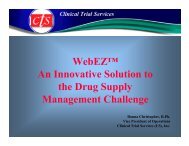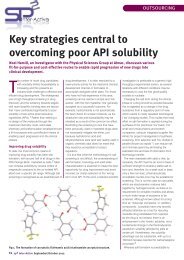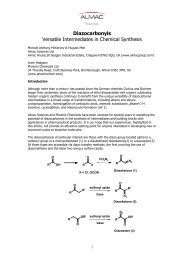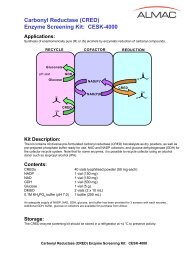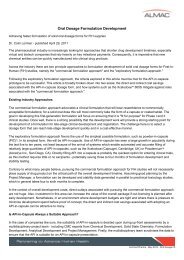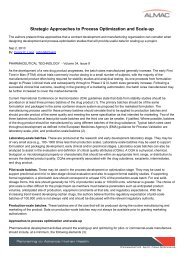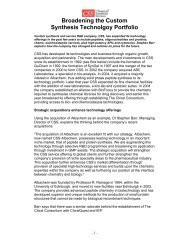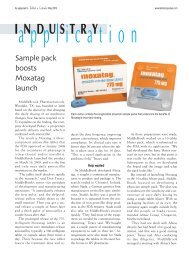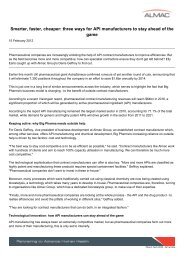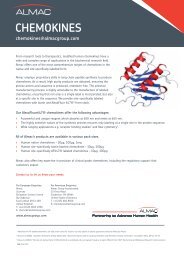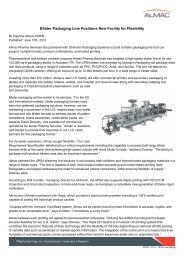QP Current Practices Challenges and Mysteries_Almac_March2012
QP Current Practices Challenges and Mysteries_Almac_March2012
QP Current Practices Challenges and Mysteries_Almac_March2012
- No tags were found...
Create successful ePaper yourself
Turn your PDF publications into a flip-book with our unique Google optimized e-Paper software.
Agenda• <strong>QP</strong> Roles <strong>and</strong> Responsibilities• <strong>QP</strong> <strong>Current</strong> <strong>Practices</strong>– Supply Chain Verification– Study Specific Information– Lot Specific Information– <strong>QP</strong> Release• <strong>Mysteries</strong>– What happens when things go wrong?
<strong>QP</strong> Roles <strong>and</strong>Responsibilities• Qualified Person must:– Ensure product has been manufactured inaccordance with»GMP»Product Specification File»Clinical Trial Application– Certify in a register or equivalentdocument that product satisfies provisionsof Article 13, 2001/20/EC.
<strong>QP</strong> Roles <strong>and</strong>Responsibilities• IMPs manufactured in a third country tost<strong>and</strong>ards at least equivalent to EUGMP• How does the <strong>QP</strong> ensure theserequirements are met in practice?
<strong>QP</strong> RELEASE PROCESS1. SupplyChainVerification2. StudySpecificInformation3. LotSpecificInformation
<strong>QP</strong> RELEASE PROCESS1. SupplyChainVerification
Sites to be verified• Chemical Drug Substance– Confirmation of compliance with at leastLocal or National GMP for• Manufacturing• Analytical Testing• Storage– No requirement for <strong>QP</strong> assessment to EUGMP compliance
Sites to be verified• Biological Drug Substance– <strong>QP</strong> assessment for compliance with EU orequivalent EU GMP• Working Cell Bank (preparation,maintenance <strong>and</strong> storage)• Manufacturing• Analytical Testing (release <strong>and</strong> stability)• Storage
Sites to be verified• Why– Essentially the same as the DP– Difficult to be an Established Process– Greater variation– Higher risk– Member States requirements vary
Sites to be verified• Drug product– <strong>QP</strong> assessment for compliance with EU orequivalent EU GMP• Manufacturing• Analytical Testing (release <strong>and</strong> stability)• Storage
Sites to be verifiedWhat does the process involve?• Risk Assessments to formally document theprocess of verification• Identify each site involved• Determine if on-site audit is required• Justification provided if on-site audit is notrequired
Continued…• Who can confirm EU GMP / equivalent EUGMP compliance– European Medicines Agency– EEA member state Competent Authoritye.g MHRA– Competent Authority within a country witha Mutual Recognition Agreement in place– <strong>QP</strong>– Under the supervision of a <strong>QP</strong>
Criteria• Scope of the audit appropriate• Outcome satisfactory• Certificate confirming EU/equivalent EU GMPcompliance• Documentation remains valid• Copy of– audit report, audit summary or supportingdocumentation– <strong>QP</strong> resume or evidence of <strong>QP</strong> eligibility
<strong>QP</strong> Declaration• May be confused with the lot specific <strong>QP</strong>Statement of Release• Signed by <strong>QP</strong>, confirming…manufacturingsites to be used outside of the EEA operateto equivalent EU GMP st<strong>and</strong>ards• Protocol <strong>and</strong> Product specific• Submitted as part of the CTA to the relevantCompetent Authority• <strong>QP</strong> is taking personal responsibility forcertifying the sites
<strong>QP</strong> Declaration• All sites verified- only sites of manufacture,packaging <strong>and</strong> labelling detailed– Czech Republic- <strong>QP</strong> Declaration to alsoincluded sites of release <strong>and</strong> stabilitytesting– Sweden- Details of site verification to beprovided in an additional memo• May be issued at client risk pendingfavourable outcome of inspection/audit• Determined as part of Risk Assessment
Common Pitfalls• All sites used in the supply chain (e.g.analytical testing labs) not identified to<strong>QP</strong>– Can occur at various stages in the study– Sub contracted sites forgotten– Assessment not performed– Possible delays
Common Pitfalls• Scope of GMP certification does notcover scope of work performed(e.g. manufacturing line or dosage form)– Inspection report covers Buildings 1,2 <strong>and</strong>3; product manufactured in Building 4– Inspection report covers solid dose- sterileinjectable in the study
Common Pitfalls• Site address or location incorrect (e.g.postal address vs building address)– Inspection report details postal address– Building Address different– Sites of actual manufacture at a separatelocation– Queries could be raised
<strong>QP</strong> RELEASE PROCESS2. StudySpecificInformation
Study SpecificDocumentation• Remember <strong>QP</strong> Legal Duties– Each batch of product has beenmanufactured…..according to GMP,Product Specification File (PSF) <strong>and</strong>Clinical Trial Application (CTA)• <strong>QP</strong> must have knowledge of– CTA which should be consistent with PSF
Continued…• Study Specific Documentation– Clinical Trial Application Form (Annex 1)– Protocol– IMPD / sIMPD / SmPC / CommercialSpecifications– IMPD Summary of Changes Document (ifapplicable)– Master English Label Text <strong>and</strong> CountrySpecific Text (as submitted)– <strong>Almac</strong> CTA Questionnaire
Continued…• Document of greatest relevance to the <strong>QP</strong>….IMPD– Contains the quality data that has beensubmitted to the Competent Authorities• Data provided on– Drug Substance– Drug Products• IMP, Comparator, NIMPs, e.g. Rescuemedication– Placebo
Continued…What is the Product Specification File?• Responsibility of the Sponsor• A ‘changing’ reference document• May consist of a number of ‘files’ in differentlocations• <strong>QP</strong> MUST have access to any information ifrequired• Assessed by Inspectors
Continued…Contains or makes reference to:– Specifications / Analytical Methods• Starting materials, packaging, intermediate, bulk<strong>and</strong> finished– Manufacturing Methods– In-process testing & methods– Approved Label Text– R<strong>and</strong>omisation Codes– Technical Agreements– Stability Data– Storage & Shipment information
Common Pitfalls• Changes to the IMPD need to becommunicated immediately• Why?– Newly imported lots (including new importsfrom bulk lots previously released) need tocomply with the currently approved versionof the CTA i.e. IMPD in the intendedcountry for release– May result in delay of release
<strong>QP</strong> RELEASE PROCESS3. LotSpecificInformation
Lot Specific Information• Remember <strong>QP</strong> Legal Duties….– Each batch of product has beenmanufactured <strong>and</strong> assembled according toGMP, PSF <strong>and</strong> Clinical Trial Application• <strong>QP</strong> must therefore have knowledge of thespecific lot of– Drug Substance– Drug Product– Placebo
Documentation requiredFor Drug Substance, Drug Product, Placebo• Certificate of Analysis– To verify compliance with the specification inthe IMPD / sIMPD• Lot specific GMP Statement for the manufacture,testing & packaging / labelling– To verify manufacture in accordance withGMP
Continued…• Critical or major deviations / Out of Specificationinvestigations for manufacture / storage / testing– Drug Product– Placebo• Why?– To identify any possible impact on• Product quality• Patient Safety
Continued…• Biological Drug Substance– Critical or major deviations / OOS for APImanufacture /storage / testing• Why?– GMP starts from maintenance of the WorkingCell Bank– <strong>QP</strong> must assess to identify possible impact on• Product quality• Patient safety
Continued…• Stability Memo <strong>and</strong> supporting stability data– In support of extension plan– Must be comprehensive– Substantial Amendment may need to be filed later• Why?– <strong>QP</strong> must confirm shelf life for Drug Productcomplies with available stability data.
Continued…• Memo to confirm the Manufacturing <strong>and</strong> testingsites as applicable• Why?– To confirm supply chain remains inaccordance with• IMPD/sIMPD• <strong>QP</strong> Declaration (if applicable)
Continued• Documentation required for EU Licensed DrugProducts– Commercial pack direct from manufacturer• <strong>QP</strong> Certification– Wholesale dealer• Statement of Authenticity / ‘Pedigreedocument’– Manufacturer supplied Brite Stock• Memo from <strong>QP</strong> to confirm productcompliance with MA with any exceptionsidentified (e.g. labelling)
Continued• Non- EU Licensed Drug Products– Difficulties when establishing supply chain– Confirm EU GMP / EU GMP equivalency ofsupply chain– Preference is to use EU licensed DrugProducts where possible– The specific documents required areassessed on a case by case basis• <strong>QP</strong> involved during submission• Advise on exact means of verification– Recent <strong>Almac</strong> experience- MHRA acceptance
Common Pitfalls• Finished Goods Lot– Is the entire supply chain for product to bereleased consistent with IMPD / <strong>QP</strong>Declaration?– Are the languages on the labels consistent withthe destination countries?– Cold chain product – Any temperatureexcursions justified?
ContinuedLicensed Drug Products– Does the CTA take into account anymodification in relation to the MA or equivalent?– Are NIMPs in the study truly NIMPs?– Is the Drug Product the same as that detailed inthe CTA?– Is the expiry date the same or less than theexpiry date of the licensed lot?– Be wary of counterfeit material?
Common pitfalls- Shelf life detailed in IMPD not reflected indrug product labelling- Regulatory Authorities or <strong>QP</strong> not informed ofchanges- Critical path- may result in delay in <strong>QP</strong>Release!
<strong>QP</strong> release• Remember <strong>QP</strong> Legal Duties…<strong>QP</strong> is to certifybatches prior to use in a Clinical Trial– Study Specific <strong>and</strong> Lot specific informationin place– <strong>QP</strong> release• Lots specific Checklist– Details checks to verify compliance• CTA Questionnaire– Provides details of regulatory status incountry for release– Blinded <strong>QP</strong> Statement of Release
Updates• Annex 13 compliant– Manufacturer’s Authorisation Number– Expiry date• IVR controlled– Strongly controlled within inventory whenlabel does not detail expiry date– <strong>Challenges</strong> to sponsor when product leaves<strong>QP</strong> inventory system– Is there adequate control at patient level?– Enhanced regulatory scrutiny in <strong>QP</strong>’sinvolvement in IVRS design
Updates• <strong>QP</strong> Facilitation Programme at site– Aimed to remove <strong>QP</strong> release from thecritical path– Quality Compliance Manager placed onsite– Information gathering– Establishing relationships– Educating– Beneficial to both Sponsor <strong>and</strong> <strong>Almac</strong>
<strong>Mysteries</strong>• What happens when things go wrong?– Controls in place have not been ‘effective’?• Manufacturing sites – inspectionsindicate critical findings• Lot specific non conformities identifiedpost release• Recall– Panic- not an option
Continued…• Common goal for both Sponsor <strong>and</strong> <strong>QP</strong>– Patient Safety– Maintain Drug Supply– Minimal study impact• Communication of paramount importance– Sponsor <strong>and</strong> <strong>QP</strong>– <strong>QP</strong> <strong>and</strong> Regulators
Continued• Additional information required• Sponsor supplied Risk Assessment• <strong>Almac</strong> Risk Assessment– Impact Assessment• Discussions with Regulator as required• Outcome determined; Product to– Remain at site– Be recalled– Be released
Summary• <strong>QP</strong> Roles <strong>and</strong> Responsibilities• <strong>QP</strong> <strong>Current</strong> <strong>Practices</strong>– Supply Chain Verification– Study Specific Information– Lot Specific Information– <strong>QP</strong> Release• <strong>Mysteries</strong>– What happens when things go wrong?




